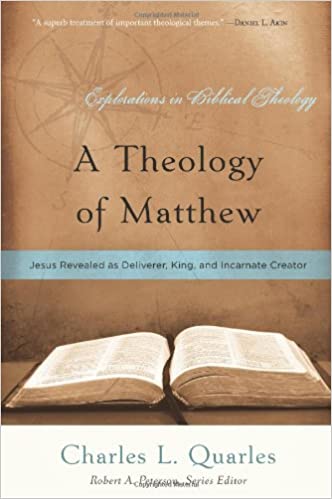A Book Review from Books At a Glance
by Mark Baker
Charles Quarles has devoted much of his career to Matthew’s Gospel. He has published a commentary on the Sermon on the Mount (B&H, 2011) as well as the Exegetical Guide of the Greek New Testament volume on Matthew (B&H, 2017). In 2013 he published the current book under consideration, A Theology of Matthew, a little gem in P&R’s Explorations in Biblical Theology series. The series offers a “midrange approach,” bridging the gap between technical theology and semi-popular books.
The first two chapters provide introductory material. The first summarizes general introductory matters such as authorship, date, and structure. The second chapter is a theological introduction that focuses on Matthew’s theological trajectories. Quarles argues that Matthew 1:21 is “the programmatic statement of the gospel” (20), and he shows how this statement depicts Jesus as both savior and divine. He also puts forward the fascinating hypothesis that Matthew saw himself as a scribe who “brings out of his treasure what is new and what is old” (13:52). It follows that Matthew’s Gospel should be organized by four key ways in which Jesus fulfills the Old Testament expectation: Jesus is the new Moses, the new David, the new Abraham, and the new Creator. Quarles shows how each of these themes point towards the divinity of Christ.
By Quarles’s own admission, the book is more a theology of Matthew’s Christology than a theology of Matthew’s entire Gospel (16). I agree that Christology is central to Matthew’s theology, but I still found myself wanting more treatment on other key aspects of Matthew, such as a more robust engagement with Jesus’ ethical teaching in the Sermon on the Mount. Perhaps that theme could have even fit into Quarles’ schema under Jesus as the new Moses.
The book largely succeeds in its “midrange approach.” Though the font size is fairly large, I was amazed at how much keen insight Quarles was able to pack into each chapter. The writing is approachable and user-friendly, but it is not at the cost of any depth of the subject matter. Some readers may get bogged down in the treatment of the Titles of Jesus. Lay people will probably not be able to navigate through the difference between the Old Greek text of Daniel and Theodotion’s Greek version. Nevertheless, Greek and Hebrew words are transliterated in the main text (but not in the footnotes), and Quarles’ observations are so compelling that readers will want to push through the more complicated spots.
I was also puzzled at the organization of the three chapters in Part 5 on Jesus as the New Creator. Chapters 9 (“The Titles of Jesus”) and 10 (“Other Descriptions of Jesus”) seemed only to fit marginally under the rubric of “New Creator,” and perhaps could have been better categorized as Jesus’ general fulfillment of Old Testament expectation.
These minor quips aside, I can confidently say that A Theology of Matthew does an excellent job of exulting in the God-man Jesus Christ. The section on worship (185-189) was especially powerful as an invitation to application. The book can be used as an aid in personal study of Matthew, as a resource for a Bible study or Sunday school class, or as a textbook for a college or seminary. With its focus on the divinity of Christ, it would be an excellent aid for apologetics, especially in conversations with Jehovah’s Witnesses and Muslims. A Theology of Matthew is certainly on my short list of book recommendations for the study of the First Gospel.
Mark Baker (PhD, Southeastern Baptist Theological Seminary) serves as professor and assistant director at the Scarborough College Darrington campus in Houston, TX.
Copyright 2021, Books at a Glance
Books at a Glance book summaries are available by subscription only and except for brief quotes may not be reproduced, in whole or in part, without express, written permission.
